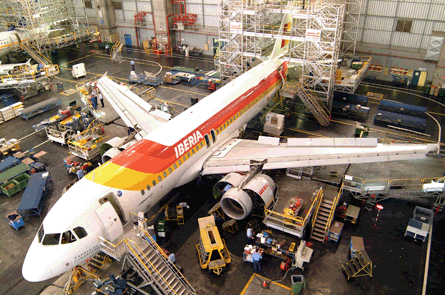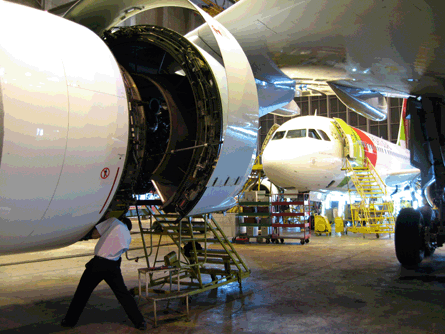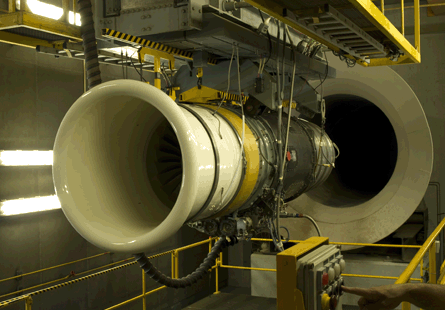The latest major change in the maintenance, repair and overhaul (MRO) industry on the Iberian Peninsula was the merger between Iberia Maintenance and British Airways' technical arm, BA Engineering, when their parent carriers formed International Airlines Group (IAG) at the end of last year. While the Spanish part of the business had long been a main aftermarket player, for the UK side it was a return to the stage after a 10 to 15-year absence from the third-party sector, except for line and certain component maintenance services which it had offered.
Apart from a capability overlap for Airbus A320-family airframe and component support, both businesses complement each other. Iberia Maintenance focuses on Airbus models, while BA Engineering has a long-standing expertise for Boeing aircraft.
With their capabilities and capacity combined, the two partners have taken a step significantly closer to their largest European competitors - Air France Industries KLM Engineering and Maintenance, Lufthansa Technik and SR Technics - in terms of airframe and component support.
 |
|---|
© Iberia |
Deciding about the future engine MRO strategy, however, "will probably be a difficult question", says José Luis Quirós Cuevas, sales, marketing and business development vice-president at Iberia Maintenance.
BA sold its engine overhaul shop in Nantgarw, near Cardiff, to General Electric in the early 1990s, while the Madrid base provides full support for CFM International CFM56-5A/B/C and -7B, Pratt & Whitney JT8D, Rolls-Royce RB211-535, GE CF34-3 and, in future, CF34-8 series engines.
"We have a good setup for the next, probably, five to seven years," says Quirós Cuevas.
What happens beyond that will depend on the arrival of new powerplant generations, market developments and the further movements by the original equipment manufacturers (OEMs) to increase their aftermarket share, he adds.
In July, IAG agreed a 15-year maintenance contract with GE for the CF6-80E1 engines of up to 16 A330-300s, which are to replace Iberia's A340-300s, because that fleet does not warrant establishing overhaul capabilities for a new engine family, according to Quirós Cuevas. Nevertheless, he expects the MRO company will provide third-party powerplant support for "many years" to come.
"I think the industry needs MROs that are not fully tied to the OEMs, because competition is what brings efficiency into the airlines in the end," he says.
Given Iberia Maintenance's current setup, it appears that future engine capabilities will likely revolve around the parent carrier's large narrowbody fleets.
This would either involve the CFM56-sucessor Leap-X, or competing Pratt & Whitney PW1000G geared turbofan. Thus far, neither Iberia nor BA have indicated how to replace their respective CFM56 and International Aero Engines V2500-powered A320-family fleets.
For the time being, both MRO partners want to grow their component business through better coordination of their mutual capabilities and capacity, as well as joining their inventory. BA Engineering plans to expand its capabilities to support 737 Next Generation components, but Iberia Maintenance will develop its services further.
"Customers want one or two suppliers for their whole range of components," Quirós Cuevas says. "Obviously, it is not possible to offer 100% [of the equipment], but we need to keep our capability as wide and large as possible."
With both companies' existing facilities located in Western Europe, airframe heavy maintenance is unlikely to be an area of great expansion. This could change, however, with new IAG members, who might have their own MRO operations.
"Mergers and acquisitions [M&A] is something that is always considered. But I think that if we, at a certain point, enter in this [M&A] direction, it would be to become more global," Quirós Cuevas says.
With regard to the aviation industry as a whole, he adds that "sooner or later Africa [and] Latin America will be places where this infrastructure will be needed, basically on the airframe side."
TAP MAINTENANCE & ENGINEERING
Across the border, TAP Maintenance & Engineering has already grown its footprint in Latin America - which both Iberian nations have close historical links with. The Portuguese MRO provider took over Varig's former technical arm, VEM, in Rio de Janeiro and Porto Alegre, Brazil, in 2005.
Nevertheless, Carlos Ruivo, marketing and sales vice-president, is sure that the merger between Iberia Maintenance and BA Engineering has significantly changed the regional balance. "No doubt there will be an impact, mainly in the engine business," he says.
 |
|---|
© TAP Maintenance & Engineering |
The mainstay of the firm's powerplant overhaul shop in Lisbon is the CFM56 family, with capabilities for -3/5A/5B/5C and -7B engines.
About two-thirds of the facility's volume, which can accommodate up to approximately 120 heavy shop visits per year, is third-party work. The maintenance provider is currently evaluating whether to expand its existing support for the CF6-80C2, which was used on the parent carrier's former A310 fleet, to the -80E1 variant for its A330s.
"We definitely have to grow in the engine business," says Ruivo. This could be alone or through co-operation with an external partner.
He does not rule out a tie-up with a manufacturer, but is cautious about the prospect of giving up the company's independence. "Partnerships with the OEMs are still something that is not easy to manage," he says.
Last year, however, an agreement with Pratt & Whitney Canada turned the site in Porto Alegre into an authorised service centre for PW100 and testing facility for PT6A turboprop engines. The agreement with the United Technologies subsidiary could prove to be a door-opener for further cooperation.
In the long-term, TAP is considering supporting the Leap-X or PW1000G engines, according to Ruivo. Thus far, however, the company has mainly studied the geared turbofan, he says.
Further growth is to come through the component MRO business. The company sees its role as a maintenance partner for small fleet operators, which covers a full range of airframe, engine and component services.
At the moment, it supports between 80 and 90% of the onboard equipment for A320-family aircraft, according to Ruivo.
Given TAP's order for a dozen A350s, the company is considering whether to service the components for the future long-haul twinjet, too. "We are evaluating the possibility to build some partnership for A350 components," he says. "That is something that is not realistic for our size to go alone."
OGMA'S EXPANSION
Expanding the commercial MRO business is also the objective of maintenance provider and aerostructure manufacturer OGMA Indústria Aeronáutica de Portugal, in Alverca, near Lisbon.
The company generates annual revenues of around €105 million ($143 million) for defence and civilian MRO services, and €35-40 million for part and subassembly production - such as the centre fuselage of the Airbus Military C-295 transport - and most of the Pilatus PC-12 airframe structure.
Over the next five years, there is potential for MRO custom to increase by 50%, according to Mário Lobato de Faria, vice-president aviation services business. Engine and component support will be the main areas for this growth plan.
At the moment, the company maintains Lockheed Martin C-130 transport and P-3 maritime patrol aircraft, including their Rolls-Royce T56 engines and parts of their onboard equipment, for defence customers.
 |
|---|
© OGMA |
This is to be complemented by the C-295 in future. Accreditation to become an authorised service centre for the twin turboprop is under way, reports Lobato de Faria. On the civilian side, OGMA currently supports the A320-family, as well as the Embraer ERJ-145 regional jet and its Legacy business aircraft sibling.
The Brazilian airframer is OGMA's largest shareholder, with a 45.5% stake, and has executive control. The European Aeronautic Defence and Space Company holds 19.5%, with the remaining 35% being held by the Portuguese government since privatisation in 2005.
Also planning to support commercial engines in the future, the company has set its sights on the PW1000G and Leap-X families, says Lobato de Faria. He adds that a decision is to be made in 2012, and that the respective capabilities would be established "within the next three years".
Given that the GTF is scheduled to enter service in 2013 and, conversely, the Leap-X is not due to start flying commercially until 2016, this would suggest that the Pratt & Whitney model ranks at the top of OGMA's agenda.
Interestingly, Lobato de Faria plays down any possible significance of the IAE V2500 for the company, even though Embraer recently selected the engine for its planned KC-390 tactical transport - and OGMA is a main supplier for that programme. "We are not putting too much focus on that [engine] right now," he says. "There is still a process of knowing who are going to be all the users for the KC-390."
Whatever the engine model the company will select, it will not need to construct new buildings for its MRO expansion plans. The 400,000m² (4,305,000ft²) site comprises 11 hangars.
"Basically, we can accommodate this growth in our facilities," Lobato de Faria says.
One main ingredient of the expansion is to become more efficient - and thus to improve the company's performance. Apart from this theory, the strategy will be to enter new markets, especially Asia and Latin America.
In the latter region the company seems to have a natural advantage.
Source: Flight International



















